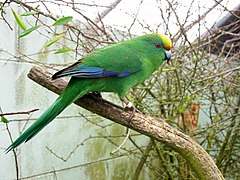Cyanoramphus
Cyanoramphus – rodzaj ptaków z podrodziny dam (Loriinae) w obrębie rodziny papug wschodnich (Psittaculidae).
| Cyanoramphus[1] | |||
| Bonaparte, 1854[2] | |||
 Przedstawiciel rodzaju – modrolotka mała (C. malherbi) | |||
| Systematyka | |||
| Domena | |||
|---|---|---|---|
| Królestwo | |||
| Typ | |||
| Gromada | |||
| Podgromada | |||
| Infragromada | |||
| Rząd | |||
| Rodzina | |||
| Podrodzina | |||
| Plemię | |||
| Rodzaj |
Cyanoramphus | ||
| Typ nomenklatoryczny | |||
|
Psittacus zealandicus Latham, 1790 | |||
| Synonimy | |||
|
| |||
| Gatunki | |||
| |||
Zasięg występowania edytuj
Rodzaj obejmuje gatunki występujące na Nowej Kaledonii, Norfolku, Lord Howe, Wyspach Antypodów, Nowej Zelandii i Chatham[8].
Morfologia edytuj
Długość ciała 20–30 cm; masa ciała 50–113 g[8].
Systematyka edytuj
Etymologia edytuj
- Cyanoramphus (Cyanorhamphus, Cyanorhynchus (gr. ῥυγχος rhunkhos „dziób”)): gr. κυανος kuanos „modry, ciemnoniebiesk”i; ῥαμφος rhamphos „dziób”[9].
- Bulleria: Sir Walter Lawry Buller (1838–1906), nowozelandzki prawnik, ornitolog[10]. Gatunek typowy: Platycercus unicolor Lear, 1831.
- Notopsittacus: gr. νοτος notos „południe, południowy zachód”; ψιττακος psittakos „papuga”[11]. Gatunek typowy: Psittacus ulietanus J.F. Gmelin, 1788.
- Phippspsittacus: Graeme R. Phipps, australijski awikulturolog i konserwatysta; gr. ψιττακος psittakos „papuga”[12]. Gatunek typowy: Psittacus novaezelandiae Sparrman, 1787.
- Pallacidopsittacus: gr. παλλακις pallakis, παλλακιδος pallakidos „konkubina”; ψιττακος psittakos „papuga”[13].
Podział systematyczny edytuj
Do rodzaju należą następujące gatunki[14]:
- Cyanoramphus zealandicus (Latham, 1790) – modrolotka czarnoczelna – takson wymarły, występował na Tahiti[15]
- Cyanoramphus ulietanus (J.F. Gmelin, 1788) – modrolotka brązowogłowa – takson wymarły[15], występował na Raiatea[16]
- Cyanoramphus saisseti J. Verreaux & Des Murs, 1860 – modrolotka żółtawa
- Cyanoramphus forbesi Rothschild, 1893 – modrolotka szmaragdowa
- Cyanoramphus cookii (G.R. Gray, 1859) – modrolotka kozia
- Cyanoramphus unicolor (Lear, 1831) – modrolotka zielona
- Cyanoramphus auriceps (Kuhl, 1820) – modrolotka żółtoczapkowa
- Cyanoramphus malherbi Souancé, 1857 – modrolotka mała
- Cyanoramphus hochstetteri (Reischek, 1889) – modrolotka złotawa
- Cyanoramphus novaezelandiae (Sparrman, 1787) – modrolotka czerwonoczelna
Uwagi edytuj
Przypisy edytuj
- ↑ Cyanoramphus, [w:] Integrated Taxonomic Information System (ang.).
- ↑ Ch.L. Bonaparte. Tableau des Perroquets. „Revue et Magasin de Zoologie pure et appliquée”. 2e Série. 6, s. 153, 1854. (fr.).
- ↑ P.L. Sclater. On the Zoology of New Guinea. „Journal of the proceedings of the Linnean Society”. 2, s. 164, 1858. (ang.).
- ↑ A. Newton: A dictionary of birds. London: A. and C. Black, 1893–1896, s. 686. (ang.).
- ↑ T. Iredale & G.M. Mathews. Descriptions of new genera. „Bulletin of the British Ornithologists’ Club”. 46, s. 76, 1926. (ang.).
- ↑ a b I.A.W. McAllan & M.D. Bruce: The birds of New South Wales: a working list. Turramurra: Biocon Research Group in association with the New South Wales Bird Atlassers, 1988, s. 45. ISBN 0-958751609. (ang.).
- ↑ R. Wells & R. Wellington. A classification of the cockatoos and parrots (Aves: Psittaciformes) of Australia. „Sydney Basin Naturalists”. 1, s. 126, 1992. (ang.).
- ↑ a b S.M. Billerman: Old World Parrots (Psittaculidae), version 1.0. W: S.M. Billerman, B.K. Keeney, P.G. Rodewald & T.S. Schulenberg (red.): Birds of the World. Ithaca, NY: Cornell Lab of Ornithology, 2020. DOI: 10.2173/bow.psitta4.01. [dostęp 2020-10-23]. (ang.).
- ↑ The Key to Scientific Names ↓, Cyanoramphus [dostęp 2023-04-26].
- ↑ The Key to Scientific Names ↓, Bulleria [dostęp 2023-04-26].
- ↑ The Key to Scientific Names ↓, Notopsittacus [dostęp 2023-04-26].
- ↑ The Key to Scientific Names ↓, Phippspsittacus [dostęp 2023-04-26].
- ↑ The Key to Scientific Names ↓, Pallacidopsittacus [dostęp 2023-04-26].
- ↑ Systematyka i nazwy polskie za: P. Mielczarek, M. Kuziemko: Plemię: Platycercini Selby, 1836 (Wersja: 2023-04-08). [w:] Kompletna lista ptaków świata [on-line]. Instytut Nauk o Środowisku Uniwersytetu Jagiellońskiego. [dostęp 2023-04-26].
- ↑ a b BirdLife International, Cyanoramphus zealandicus, [w:] The IUCN Red List of Threatened Species 2020, wersja 2020-2 [dostęp 2020-10-23] (ang.).
- ↑ BirdLife International, Cyanoramphus ulietanus, [w:] The IUCN Red List of Threatened Species 2020, wersja 2020-2 [dostęp 2020-10-23] (ang.).
Bibliografia edytuj
- The Key to Scientific Names, J.A. Jobling (red.), [w:] Birds of the World, S.M. Billerman et al. (red.), Cornell Lab of Ornithology, Ithaca (ang.).
Identyfikatory zewnętrzne: